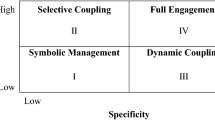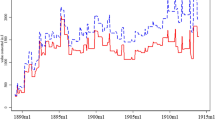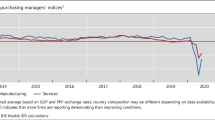Abstract
The purpose of this paper is to propose an analytical framework integrating the diverse explanations of the failure of IMF conditionality. The IMF is a key player in the running of markets in a global economy. The institutional failures of IMF conditionality are appreciated at two complementary levels: (a) its intrinsic bureaucratic bias, and (b) the inability of the IMF to manage the institutional change required for the development of market processes. A new approach of conditionality suggests the separation of the role of the IMF as financial backer from its role as adviser to countries confronted by the globalization process.
Similar content being viewed by others
Notes
After 1982, a steady increase in procedural conditionality can be observed.
According to Article I of the Articles of Agreement, one of the purposes of the IMF is “to give confidence to members by making the general resources of the Fund temporarily available to them under adequate safeguards, thus providing them with opportunity to correct maladjustments in their balance of payments without resorting to measures destructive of national or international prosperity.” In other words, the original conception of IMF lending was to allow countries to make an adequate trade-off between adjustment and financing.
Mussa and Savastano (2000), for example, studied 615 IMF arrangements over the 1973–1997 period using a sample composed of 5 industrial countries and 121 developing countries. Their main result was that more than a third of IMF programs ended with disbursements of less than half of the support initially agreed to. An extensive empirical literature confirms this poor completion of IMF programs.
Studying 77 developing countries between 1975 and 1999, Joyce (2006) shows that successful program implantation is affected by domestic political considerations, notably the degree of democracy, the degree of election competitiveness and the degree of political pluralism.
Based on a sample of 106 countries that obtained IMF credit over the period of 1971–1997.
For example, governments can use IMF credits to make foreign exchange interventions in order to sustain the exchange rate regimes after a monetary expansion.
The determinants of the political connections are the following: country quota, the number of nationals amongst the IMF staff, and member country’s political and economic proximity to the IMF’s major shareholding countries. Each of these determinants exerts a significant influence on IMF loans.
Decisions to lend are analyzed over the period of 1985–1994 for 87 developing countries.
38 countries over the period of October 1997–March 2003 are studied. The relationship between the US and the recipient country is identified through voting in the United Nations General Assembly. The two countries are considered as allies when they vote in the same direction.
Their study uses two main statistical sources: a chronological study from 1958 to 1999; an econometric analysis over the period of October 1997–March 2003 for 206 IMF letters of intent concluded with 38 countries. “Conditionality increases when the demand for IMF credit grows relative to quota; (...) conditionality decreases or stagnates when the demand for IMF credit is weak or IMF quotas have been raised” (Dreher & Vaubel, 2004b: 10).
The Managing Director and Deputy Managing Directors.
Svensson (2003) confirms this result using data from around 200 structural adjustment programs from the World Bank over the period of 1980–1995.
Vaubel (1991) has made a similar suggestion.
IMF Press Release, no. 03/207, November 26, 2003.
As suggested, among others, by the Advisory Commission.
Adopting a different perspective, Willett (2005) suggests separating IMF programs into two major categories: a short-term facility with ex ante conditionality, and structural conditionality.
This argument naturally rests on the idea that the knowledge disseminated by institutions is of a stabilizing nature, in that it reaffirms the stability of the social structure at regular intervals, unlike that disseminated by the price system, which is of a dynamic nature in that it leads individuals to revise their plans continually (Hayek, 1945).
“SBMs are indicators which aim to delineate the expected path of reform for individual structural policy measures and that can facilitate the evaluation of progress for these actions. Because many structural policies cannot be expressed in quantitative form, structural benchmarks are usually expressed qualitatively; for example, if the program calls for privatization of the state-owned telephone company, submitting the privatization bill to the legislature by date x could be one structural benchmark. Failure to meet structural benchmarks conveys a negative signal but does not automatically render a country ineligible to draw; instead, a decision about eligibility would be judgmental and would likely be made in a broader mid-year program review—itself an instrument of conditionality—with an eye toward the country’s overall progress on the structural front” (IMF, 2001c).
“The majority of structural conditions—between a half and two thirds—have been, and continue to be, concentrated in a relatively small number of sectors that are at the very core of the Fund’s involvement in member countries: exchange and trade systems, and fiscal and financial sectors. The relative importance of these sectors has changed, with reforms in the exchange and trade system now playing a smaller role and the financial sector a more important one than in the early 1990s. In addition, public enterprise restructuring and privatization—in part motivated by fiscal considerations—have accounted for about one fifth of the structural conditions in Fund-supported programs. Nevertheless, while a large part of structural conditionality has focused on a relatively small number of sectors that are closely linked to stabilization and external adjustment, this does not guarantee that structural reforms have always been adequately prioritized nor does it imply that too broad a reform agenda has never been an issue” (IMF, 2001a).
Only this latter type of change is likely to disrupt some plans in the course of action.
Numerous empirical studies have established this relationship. See Collier et al. (1998).
IMF defines ownership as follows: “ownership is a willing assumption of responsibility for an agreed program of policies, by officials in a borrowing country who have the responsibility of formulating and carrying out those policies, based on an understanding that the program is achievable and is in the country’s own interest” (IMF, 2001b: 6).
In 1999, the IMF and the World Bank initiated the Poverty Reduction Strategy Papers which give a greater degree of initiative to governments in low-income countries. Indeed, PRSPs are prepared by governments according to a participatory process involving domestic stakeholders. A PRSP describes the macroeconomic, structural and social policies and programs adopted by a country for several years (IMF, 2003a). In August 2006, 78 countries were eligible for the Poverty Reduction and Growth Facility. The last IMF review available (September 2005) shows that 49 full PRSPs have been circulated to the Fund Executive Board and an additional 11 countries have completed “interim” PRSPs. Although it is too early to evaluate them, preliminary assessments have stressed the participatory gap after the adoption of the programs and the conflicts between their multiple objectives, revealing the difficulty in adopting a clear priority order. For an external evaluation of PRSP, see Killick (2002) and Independent Evaluation Office (2005a); for an internal evaluation, IMF (2003b).
Nigeria has been the first IMF-member to use PSI in October 2005.
The duration is between 1 year and 3 years with a maximum of 4 years.
References
Allegret, J. P., Courbis, B., & Dulbecco, P. (2003). Financial liberalization and stability of the financial system in emerging markets: The institutional dimension of financial crises. Review of International Political Economy, 10(1), 73–92.
Baliño, T. J. T., Enoch, C., Gulde, A. M., Lindgren, C. J., Quintyn, M., & Teo, L. (2000). Financial sector crisis and restructuring: Lessons from Asia. IMF Occasional Paper, no.188, January.
Barro, R. J., & Lee, J. W. (2005). IMF programs: Who is chosen and what are the effects? Journal of Monetary Economics, 52(7), 1245–1269.
Berkowitz, D., Pistor, K., & Richard, J. F. (2003). Economic development, legality, and the transplant effect. European Economic Review, 47(1), 165–195.
Bevan, D. (2005). The IMF and low-income countries. World Economics, 6(2), 66–85.
Collier P., Guillaumont P., Guillaumont S., & J. W. Gunnig (1997). Redesigning Conditionality. World Development, 25(9), 1399-1407.
Collier, P., Gunning, J. W., & Hamada, K. (1998). Report of the group of independent persons appointed to conduct an evaluation of certain aspects of the enhanced structural adjustment facility. Washington DC: IMF.
Dollar, D., & Svensson, J. (2000). What explains the success or failures of structural adjustment programs? Economic Journal, 110(October), 894–917.
Dreher, A. (2003). The influence of elections on IMF program interruptions. The Journal of Development Studies, 39(6), 101–120.
Dreher, A. (2004). A public choice perspective of IMF and World Bank lending and conditionality. Public Choice, 119(3), 445–464.
Dreher, A. (2006). IMF conditionality: Theory and evidence. Paper prepared for the Independent Evaluation Office of the IMF, April.
Dreher, A., & Jensen, N. (2007). Independent actor or agent? An empirical analysis of the impact of US interests on IMF conditions. The Journal of Law and Economics, 50(1), forthcoming.
Dreher, A., & Vaubel, R. (2004a). Does the IMF and IBRD cause moral hazard and political business cycles? Evidence from panel data. Open Economies Review, 15(1), 5–22.
Dreher, A., & Vaubel, R. (2004b). The causes and consequences of IMF conditionality. Emerging Markets Finance and Trade, 40(3), 26–54.
Edwards, M. S. (2001). Sticking with yes: Domestic institutions and IMF compliance. Paper presented at the Annual Meeting of American Political Science Association, San Francisco, September.
Goldstein, M. (2000). IMF structural conditionality: How much is too much? Paper presented at the NBER Conference on Economic and Financial Crises in Emerging Market Economies, Woodstock, Vermont, October. Institute for International Economics Working Paper Series, WP01–4.
Gould, E. R. (2003). Money talks: Supplementary financiers and International Monetary Fund conditionality. International Organization, 57(3), 551–586.
Hakura, D. S., & Nsouli, S. M. (2003). The millennium development goals, the emerging framework for capacity building, and the role of the IMF. IMF Working Paper, WP/03/119; June.
Hayek, F. (1945). The use of knowledge in society. In F. Hayek (Eds.), Individualism and economic order (1949) (pp. 77–91). London, UK: Routledge & Kegan Paul.
Independent Evaluation Office (2005a). The poverty reduction strategy initiative, findings from ten country case studies of World Bank and IMF support. Washington DC: World Bank Evaluation Department and IMF Independent Evaluation Office.
Independent Evaluation Office (2005b). Draft issues paper for an evaluation of structural conditionality in IMF-supported programs. March, Washington DC.
Independent Evaluation Office (2005c). Evaluation of the technical assistance provided by the International Monetary Fund. January, Washington D.C.
International Monetary Fund (2001a). Conditionality in fund-supported programs-policy issues. February, Washington DC.
International Monetary Fund (2001b). Strengthening country ownership of fund-supported programs. December, Washington DC.
International Monetary Fund (2001c). Streamlining structural conditionality: Review of initial experience. July, Washington DC.
International Monetary Fund (2003a). Operational guidance on the new conditionality guidelines. May, Washington DC.
International Monetary Fund (2003b). Poverty reduction strategy papers, detailed analysis of progress in implementation. September, Washington DC.
International Monetary Fund (2004). The role of the fund in low-income member countries. August, Washington D.C.
International Monetary Fund (2005a). Review of the 2002 conditionality guidelines. March, Washington D.C.
International Monetary Fund (2005b). Policy support and signaling in low-income countries. June, Washington D.C.
Ivanova, A., Mayer, W., Mourmouras, A., & Anayiotos, G. (2006). What determines the implementation of IMF-supported programs? In A. Mody & A. Rebucci (Eds.), IMF-supported programs, recent staff research (pp. 160–186). Washington D.C.
Jacobs, S. (1999). The second generation of regulatory reforms. Paper presented at the Conference on Second Generation Reforms. IMF, November 8–9.
Joyce, J. P. (2006). Promises made, promises broken: A model of IMF program implementation. Economics and Politics, 18(3), 339–365.
Kapur, D., & Webb, R. (2000). Governance-related conditionalities of the international financial institutions. Group of 24 Discussion Paper Series, 6, August.
Khan, M. S., & Sharma, S. (2006). IMF conditionality and country ownership of programs. In A. Mody & A. Rebucci (Eds.), IMF-supported programs, recent staff research (pp. 119–130). Washington D.C.
Killick, T. (2002). The ‘streamlining’ of IMF conditionality: Aspirations, reality and repercussions. A report for The Department for International Development, Overseas Development Institute, London, April.
Lachmann, L. (1970). The legacy of Max Weber. London, UK: Heinemann.
Lane, T., Ghosh, A. R., Hamann, J., Phillips, S., Schulze-Ghattas, M., & Tsikata, T. (1999). IMF-supported programs in Indonesia, Korea and Thailand. IMF Occasional Paper, 178, June, Washington DC.
Leandro, J. E., Schafer, H., & Frontini, G. (1999). Towards a more effective conditionality: An operational framework. World Development, 27(2), 285–299.
Lin, J. Y. (1989). An economic theory of institutional change: Induced and imposed change. Cato Journal, 9(1), 1–35.
Lombardi, D. (2005). The IMF’s role in low-income countries: Issues and challenges. IMF Working Paper, WP/05/177, September.
Martin, L. L. (2006). Distribution, information, and delegation to international organizations: The case of IMF conditionality. In D. G. Hawkins, D. A. Lake, D. L. Nielson, & M. J. Tierney (Eds.), Delegation and agency in international organizations (pp. 140–164). New York: Cambridge University Press.
Martin, M., & Bargawi, H. (2005). A changing role for the IMF in low-income countries. In J. J. Teunissen & A. Akkerman (Eds.), Helping the poor? The IMF and low-income countries (pp. 68–126). The Hague, The Netherlands: Fondad.
Meltzer, A. (2000). International financial institution. Advisory Commission, March, Washington DC.
Mussa, M., & Savastano, M. (2000). The IMF approach to economic stabilization. In B. S. Bernanke & J. J. Rotemberg (Eds.), NBER macroeconomics annual 1999 (pp. 79–122). Cambridge, MA: MIT Press.
O’Driscoll, G. P., & Rizzo, M. J. (1996). The economics of time and ignorance. London, UK: Blackwell.
Radelet, S., & Sachs, J. D. (1998). The East Asian financial crisis: Diagnosis, remedies, prospects. Brookings Paper on Economic Activity, 1, 1–74.
Rodrik, D. (2005). Growth strategies. In P. Aghion & S. Durlauf (Eds.), Handbook of economic growth, vol.1A (pp. 967–1014). North-Holland, The Netherlands: Elsevier.
Rodrik, D. (2006). Goodbye Washington consensus, hello Washington consensus? Journal of Economic Literature, forthcoming.
Schotter, A. (1981). The economic theory of social institutions. New York: Cambridge University Press.
Svensson, J. (2003). Why conditional aid does not work and what can be done about it? Journal of Development Economics, 70, 381–403.
Thacker, S. C. (1999). The high politics of IMF lending. World Politics, 52(1), 38–75.
Vaubel, R. (1991). The political economy of the International Monetary Fund: A public choice approach. In R. Vaubel & T. Willett (Eds.), The political economy of international organizations (pp. 205–245). Boulder, CO: Westview.
Vreeland, J. R. (2004). Institutional determinants of IMF agreements. UCLA International Institute. Global Fellows Working Papers.
Willett, T. D. (2002). Towards a broader public choice analysis of the IMF. In D. M. Andrews, C. R. Henning, & L. W. Pauly (Eds.), Organizing the world’s money, a festschrift in honor of Benjamin J. Cohen (pp. 60–77). Ithaca, NY: Cornell University Press, Claremont Colleges, Working Papers in Economics, March.
Willett, T. D. (2005). The IMF and capital account crises: The case for separate lender of last resort and conditionality functions. In G. Rannis, J. Vreeland, & S. Kosak (Eds.), Globalization and the nation state: The impact of the IMF and World Bank (pp. 351–371). London, UK: Routledge.
World Bank (1992). World Bank structural and sectoral adjustment operations: The second OED overview. Operations Evaluation Department Report 10870, June, Washington DC.
World Bank (2005). Economic growth in the 1990s: Learning from a decade of reform. Washington D.C.
Acknowledgement
We would like to thank all participants for their remarks and suggestions. The paper benefited greatly from careful readings by the two referees of the Review and the editor Axel Dreher. We thank Pauline Boerma-Collier for her very useful assistance. Usual caveats apply.
Author information
Authors and Affiliations
Corresponding author
Rights and permissions
About this article
Cite this article
Allegret, JP., Dulbecco, P. The institutional failures of International Monetary Fund conditionality. Rev Int Org 2, 309–327 (2007). https://doi.org/10.1007/s11558-006-9003-9
Received:
Revised:
Accepted:
Published:
Issue Date:
DOI: https://doi.org/10.1007/s11558-006-9003-9




